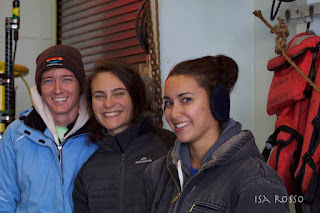Still waiting for the weather to get better. We got caught off guard by some nice big rolls (20 degrees), which made people, chairs, food, cups.. everything flying. Fortunately, no injuries!
 |
Cold and angry.
|
It's poetry, it's nature at its crude power.
The weather is slowly getting better, but there are still some really big rolls, as the swells push us to the sides.
Still waiting.
Still waiting.
This waiting is frustrating for all of us, we're eager to start working again.. The time's falling through our hands.
I spent a good portion of my morning at the bridge, today. I love coming here. The perspective of the outside world that you get from the bridge is pretty unique. Staying balanced is way harder on this top space than it is on the lower decks, and I find it pretty entertaining. I spent these hours chatting with Captain Eric, third mate Todd, ABs Pam & Jeremy. We evaluated the swells. We shared stories and pictures and great laughs.
And I learnt about the beautiful Matanuska glacier in Alaska, where you can walk on it and its perfect transparency and pureness makes it the perfect companion for a delicious glass of whiskey; not only do I want to go to Alaska now.. but I wouldn't mind a good glass of Japanese whiskey either..
And I learnt about all (ok, maybe not all) of the screens that monitor the propellers, bow thruster, generators and tanks on the ship
And I learnt about this confused sea which shoots swells at us from any corner. The constant swells have prevented us from doing any CTD stations, yet.
I imagine the drifters we sent flying into the sea getting dragged off in all directions by these erratic surface currents. One of them is our second special one, adopted by the Doral Academy of Colorado. Drifter #300234066338770 was deployed at 60S, 30E on April 22. A fun deployment, in much calmer conditions. But in these part of the world, the quiet moments don't last long.































